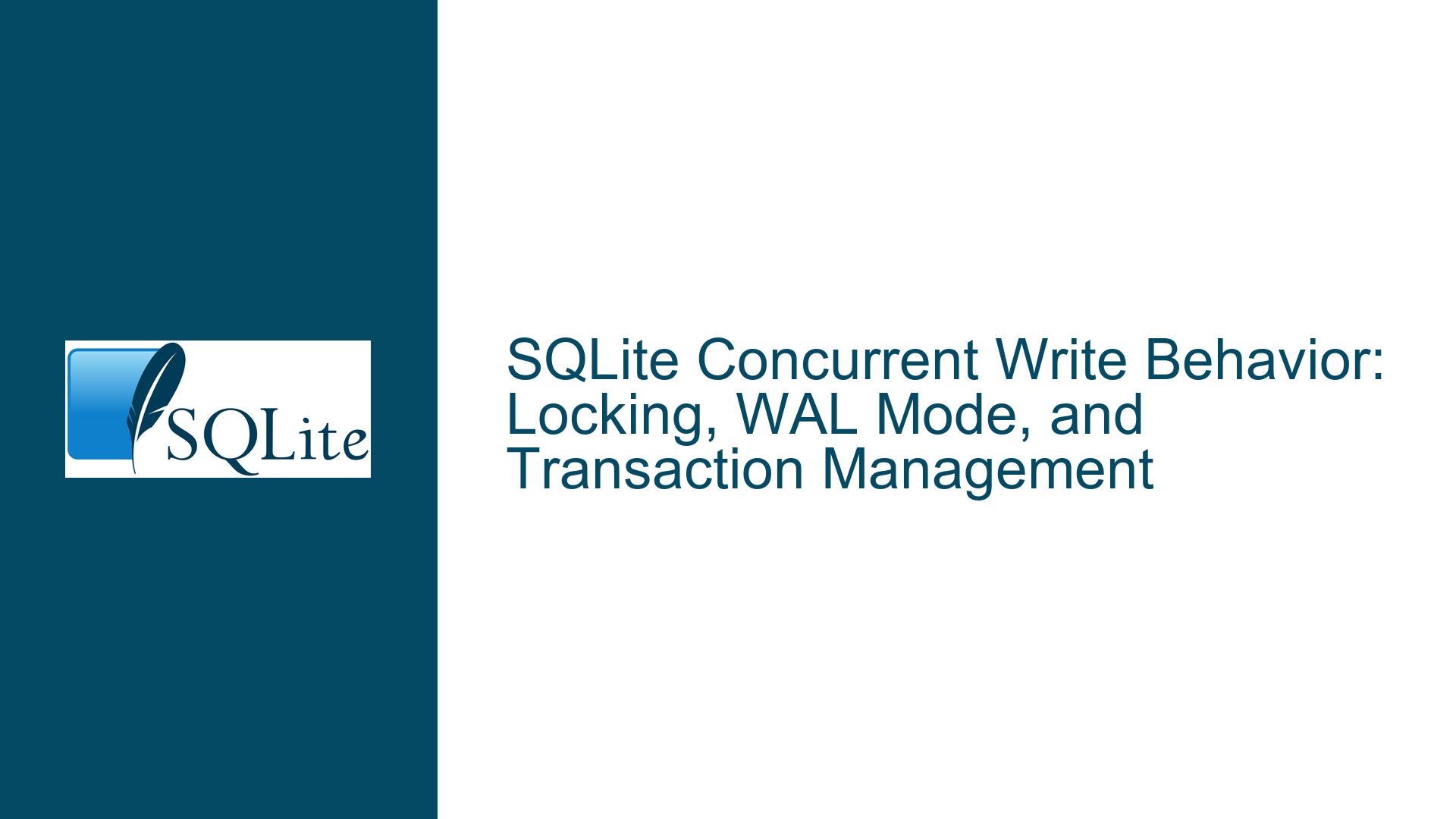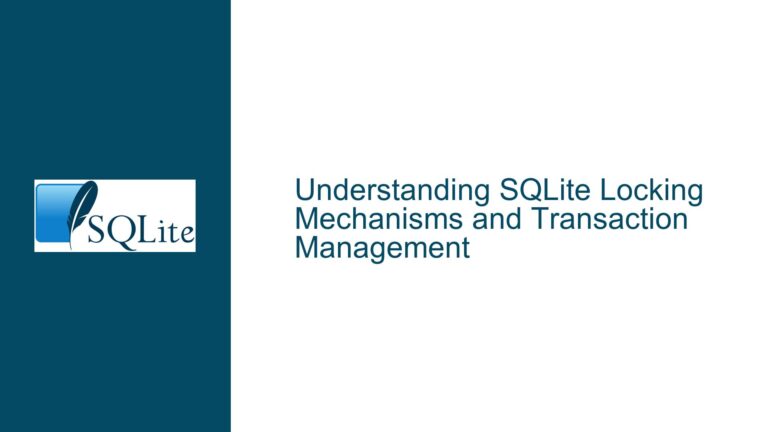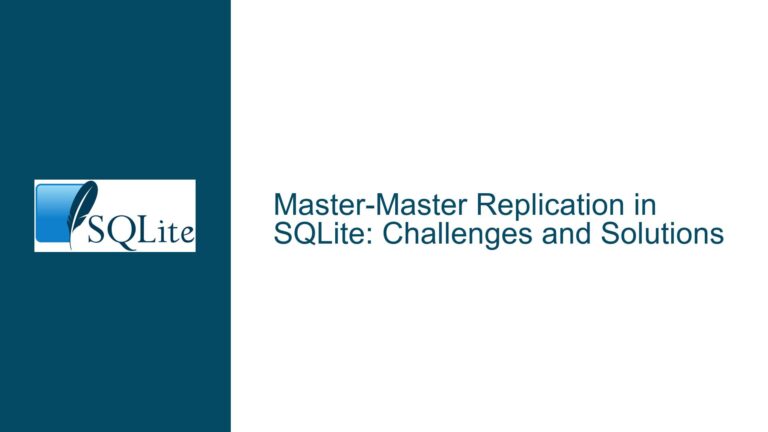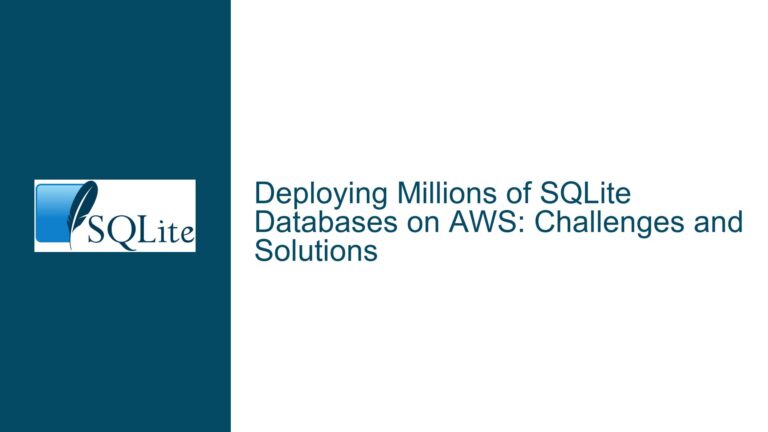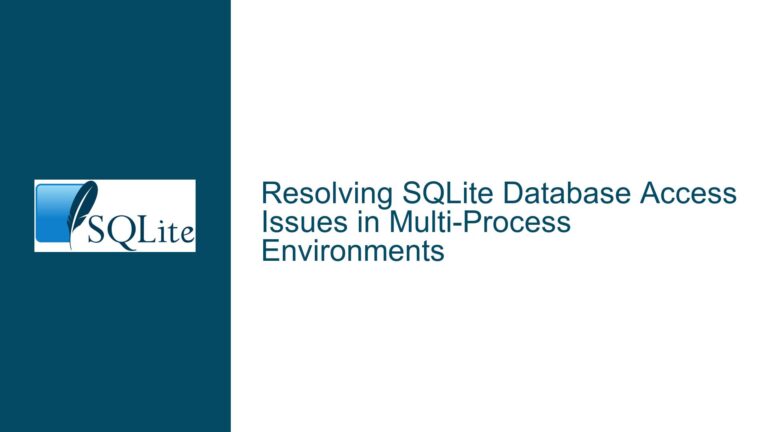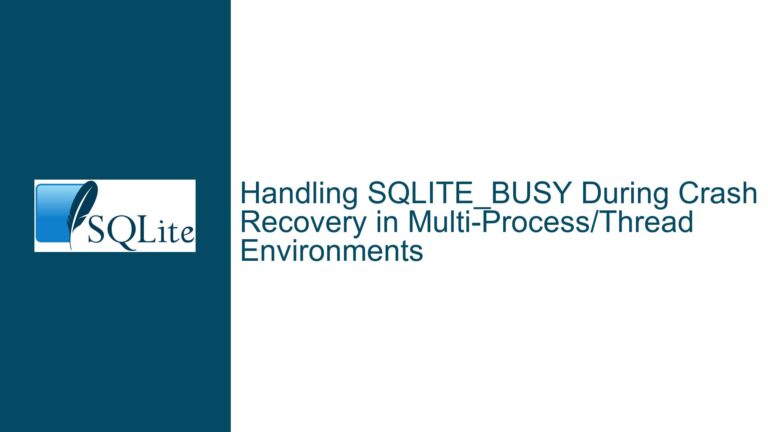SQLite Concurrent Write Behavior: Locking, WAL Mode, and Transaction Management
Understanding SQLite’s Concurrency Model: Locking States and Transaction Isolation
SQLite implements a file-based locking mechanism to coordinate concurrent access to databases. The locking protocol involves five states: UNLOCKED, SHARED, RESERVED, PENDING, and EXCLUSIVE. When a connection initiates a read operation, it acquires a SHARED lock, allowing multiple concurrent readers. Write operations require progression through RESERVED, PENDING, and EXCLUSIVE lock states. The RESERVED lock indicates intent to write while allowing existing readers to continue. The PENDING lock prevents new readers from starting while waiting for existing readers to complete. Finally, the EXCLUSIVE lock enables actual modification of the database file.
In default rollback journal mode, writers block readers during the EXCLUSIVE lock phase because the database file is being modified directly. This creates contention when multiple clients attempt mixed read/write workloads. Write-Ahead Logging (WAL) mode fundamentally changes this behavior by separating writes into a separate log file, allowing readers to continue accessing the original database file while writers append to the WAL. However, WAL mode introduces new considerations for transaction durability and checkpointing.
The key isolation level in SQLite is SERIALIZABLE. All transactions see a consistent snapshot of the database as it existed when the transaction began. Write transactions serialize through the EXCLUSIVE lock, ensuring atomic visibility of changes. In WAL mode, readers operate on the last committed snapshot, while writers append changes to the WAL file. This allows read/write concurrency but maintains strict write serialization.
Diagnosing Lock Contention: WAL Configuration, Transaction Duration, and Connection Management
Lock contention in SQLite typically manifests through SQLITE_BUSY errors or unexpected delays in query execution. The primary factors influencing contention include:
Journal Mode Configuration: The default rollback journal mode forces exclusive locking during writes, blocking all readers. WAL mode enables concurrent reads and writes but requires all processes to reside on the same host. Network file systems often implement file locking inconsistently, breaking WAL’s coordination mechanism. Verify journal mode using
PRAGMA journal_mode;and ensure WAL is properly configured withPRAGMA journal_mode=WAL;.Transaction Scope and Type: Long-running write transactions maintain EXCLUSIVE locks, delaying other writers. Implicit transactions (single statements without explicit BEGIN) have shorter duration than explicit multi-statement transactions. Transaction upgrade deadlocks occur when a read transaction (SHARED lock) attempts to write without using BEGIN IMMEDIATE. This creates a RESERVED lock while other connections might hold SHARED locks, leading to deadlock.
Busy Timeout Settings: The default busy timeout is 0 milliseconds, causing immediate SQLITE_BUSY errors. Setting
PRAGMA busy_timeout=N;(where N is milliseconds) enables automatic retries. However, excessive timeouts can mask design flaws leading to contention.Connection Sharing: SQLite connections are not thread-safe. Sharing a connection across threads without synchronization causes undefined behavior. Each concurrent thread must use separate connections. Connection pooling strategies must account for this limitation.
Checkpoint Aggressiveness in WAL Mode: The WAL file grows until a checkpoint occurs, which merges changes back to the main database. Automatic checkpoints trigger after reaching WAL file size thresholds (default 1000 pages). Long-running read transactions prevent checkpoint completion, causing WAL file bloat. Manual checkpointing with
PRAGMA wal_checkpoint(TRUNCATE);can mitigate this.
Optimizing Concurrent Access: WAL Tuning, Transaction Control, and Error Handling
Step 1: Enable and Configure WAL Mode
Execute PRAGMA journal_mode=WAL; on all connections. Verify with PRAGMA journal_mode;. Set synchronous mode to NORMAL for performance-critical applications: PRAGMA synchronous=NORMAL;. This balances durability with write performance by skipping fsync operations during WAL commits. For full ACID compliance, use PRAGMA synchronous=FULL;.
Step 2: Adjust Busy Timeout
Set a busy timeout appropriate for the workload: PRAGMA busy_timeout=30000; (30 seconds). This allows automatic retries for transient locks. Monitor SQLITE_BUSY occurrences – frequent errors indicate underlying contention issues rather than transient load.
Step 3: Control Transaction Boundaries
For write transactions:
- Use
BEGIN IMMEDIATE;to acquire a RESERVED lock upfront, preventing upgrade deadlocks. - Keep transactions short – batch large inserts into multiple transactions.
- Avoid interleaving reads and writes within the same transaction when possible.
For read transactions:
- Use
BEGIN DEFERRED;to start read-only transactions. - Release read transactions promptly to allow checkpoints in WAL mode.
Step 4: Manage Checkpoints
Monitor WAL file size with PRAGMA wal_checkpoint(TRUNCATE);. Schedule periodic checkpoints during low activity. Adjust automatic checkpoint threshold: PRAGMA wal_autocheckpoint=N; where N is page count. Consider using incremental checkpoints for large databases.
Step 5: Handle SQLITE_BUSY Gracefully
Implement retry logic with exponential backoff:
int retries = 0;
while (retries < MAX_RETRIES) {
rc = sqlite3_step(stmt);
if (rc == SQLITE_BUSY) {
sleep(2^retries);
retries++;
continue;
}
break;
}
For applications requiring strict write availability, employ a write queue with a single writer thread/process.
Step 6: Connection Pooling
Maintain separate connection pools for readers and writers. Ensure each thread acquires a dedicated connection. Use connection limits to prevent resource exhaustion. Example pool configuration:
- Writer pool: 1-2 connections
- Reader pool: N connections based on thread count
Step 7: Monitor Locking Status
Use sqlite3_db_status(db, SQLITE_DBSTATUS_LOOKASIDE_USED, ...) to monitor lock contention. Analyze via SELECT * FROM sqlite_stat1; for query optimization. Enable extended error codes with PRAGMA result_codes=ON; to distinguish between different lock contention scenarios.
Step 8: Schema Design Optimization
- Avoid table-level locks by removing unnecessary indices
- Use WITHOUT ROWID tables for clustered indexes
- Normalize data to minimize update contention
- Employ partial indexes to reduce write amplification
Step 9: Analyze Long-Running Queries
Identify problematic queries using EXPLAIN QUERY PLAN. Optimize full table scans with covering indexes. For analytical queries, consider attaching separate read-only databases or using in-memory temp tables.
Step 10: Evaluate Alternative Architectures
When write contention exceeds SQLite’s capabilities:
- Shard data across multiple database files
- Use PostgreSQL for row-level locking needs
- Implement application-level conflict resolution with SQLite’s ON CONFLICT clauses
- Offload read traffic to replicated databases using litestream or other replication tools
Deep Dive: WAL Mode Internals
The WAL file structure consists of a header (32 bytes) followed by frames (page size + 24-byte frame header). Each commit appends frames to the WAL. The shared-memory file (.shm) coordinates access through 3×32-bit counters (read/write/checkpoint marks). Readers validate the WAL by checking the magic number and checksums in the WAL header. Checkpointing involves:
- Acquiring a READ lock on the database
- Copying modified pages from WAL to database
- Updating the WAL header to reset the write counter
Transaction Lifecycle in WAL Mode
- Writer begins transaction with BEGIN IMMEDIATE
- Acquires RESERVED lock, writes changes to WAL buffer
- On commit, WAL buffer is flushed (depending on synchronous setting)
- Writer updates the WAL index in shared memory
- Readers detect new commits by checking the WAL index
- Checkpoint thread periodically merges WAL changes
Advanced Tuning Parameters
PRAGMA cache_size=-N;(set cache size to N kibibytes)PRAGMA mmap_size=3000000000;(use memory-mapped I/O for large databases)PRAGMA optimize;(run after schema changes to update query planner stats)PRAGMA threads=N;(control number of worker threads for operations like sorting)
Edge Case Handling
- Exclusive Lock Starvation: When multiple writers constantly retry, use randomized backoff in busy handlers.
- Frozen Read Transactions: Long-running reads block WAL checkpoints. Use
PRAGMA wal_checkpoint(PASSIVE);to run checkpoints without blocking. - Power Loss Recovery: WAL mode requires proper shutdown to avoid corruption. Periodically run
PRAGMA integrity_check;.
Migration Strategies from Rollback Journal
- Set WAL mode on existing database
- Vacuum to rebuild entire database in WAL format
- Adjust application transaction logic
- Update backup procedures to include WAL and shm files
- Monitor performance counters for checkpoint activity
Cross-Platform Considerations
- Windows requires the Win32 API for robust file locking
- NFS mounts may require
PRAGMA locking_mode=EXCLUSIVE; - iOS/Android implementations must handle file system notifications properly
- Docker volumes need proper mount configuration for atomic writes
Diagnostic Queries
-- Current locks
SELECT * FROM pragma_lock_status;
-- WAL statistics
SELECT * FROM pragma_wal_checkpoint;
-- Connection status
SELECT * FROM pragma_database_list;
-- Memory usage
SELECT * FROM pragma_memory_used;
Performance Metrics to Monitor
- WAL file size growth rate
- Checkpoint completion time
- Transaction commit latency
- SQLITE_BUSY error rate
- Page cache hit ratio
By systematically applying these configurations, monitoring key metrics, and adhering to SQLite’s concurrency constraints, developers can achieve robust concurrent access patterns even under heavy load. The solution requires balancing transaction granularity, timeout settings, and architectural workarounds to match specific application requirements.
